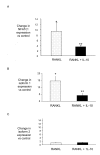Interleukin-10 inhibits osteoclastogenesis by reducing NFATc1 expression and preventing its translocation to the nucleus
- PMID: 17239241
- PMCID: PMC1781937
- DOI: 10.1186/1471-2121-8-4
Interleukin-10 inhibits osteoclastogenesis by reducing NFATc1 expression and preventing its translocation to the nucleus
Abstract
Background: IL-10 has a potent inhibitory effect on osteoclastogenesis. In vitro and in vivo studies confirm the importance of this cytokine in bone metabolism, for instance IL-10-deficient mice develop the hallmarks of osteoporosis. Although it is known that IL-10 directly inhibits osteoclastogenesis at an early stage, preventing differentiation of osteoclast progenitors to preosteoclasts, the precise mechanism of its action is not yet clear. Several major pathways regulate osteoclastogenesis, with key signalling genes such as p38, TRAF6, NF-kappaB and NFATc1 well established as playing vital roles. We have looked at gene expression in eleven of these genes using real-time quantitative PCR on RNA extracted from RANKL-treated RAW264.7 monocytes.
Results: There was no downregulation by IL-10 of DAP12, FcgammaRIIB, c-jun, RANK, TRAF6, p38, NF-kappaB, Gab2, Pim-1, or c-Fos at the mRNA level. However, we found that IL-10 significantly reduces RANKL-induced NFATc1 expression. NFATc1 is transcribed from two alternative promoters in Mus musculus and, interestingly, only the variant transcribed from promoter P1 and beginning with exon 1 was downregulated by IL-10 (isoform 1). In addition, immunofluorescence studies showed that IL-10 reduces NFATc1 levels in RANKL-treated precursors and suppresses nuclear translocation. The inhibitory effect of IL-10 on tartrate-resistant acid phosphatase-positive cell number and NFATc1 mRNA expression was reversed by the protein kinase C agonist phorbol myristate acetate, providing evidence that interleukin-10 disrupts NFATc1 activity through its effect on Ca2+ mobilisation.
Conclusion: IL-10 acts directly on mononuclear precursors to inhibit NFATc1 expression and nuclear translocation, and we provide evidence that the mechanism may involve disruption of Ca2+ mobilisation. We detected downregulation only of the NFATc1 isoform 1 transcribed from promoter P1. This is the first report indicating that one of the ways in which IL-10 directly inhibits osteoclastogenesis is by suppressing NFATc1 activity.
Figures




Similar articles
-
Interleukin-10 inhibits RANKL-mediated expression of NFATc1 in part via suppression of c-Fos and c-Jun in RAW264.7 cells and mouse bone marrow cells.Bone. 2007 Oct;41(4):592-602. doi: 10.1016/j.bone.2007.05.016. Epub 2007 Jun 13. Bone. 2007. PMID: 17627913
-
Interleukin-4 inhibits RANKL-induced expression of NFATc1 and c-Fos: a possible mechanism for downregulation of osteoclastogenesis.Biochem Biophys Res Commun. 2005 Apr 15;329(3):839-45. doi: 10.1016/j.bbrc.2005.02.049. Biochem Biophys Res Commun. 2005. PMID: 15752732
-
Serum calcium-decreasing factor, caldecrin, inhibits osteoclast differentiation by suppression of NFATc1 activity.J Biol Chem. 2010 Aug 13;285(33):25448-57. doi: 10.1074/jbc.M109.068742. Epub 2010 Jun 14. J Biol Chem. 2010. PMID: 20547767 Free PMC article.
-
Interleukin 29 inhibits RANKL-induced osteoclastogenesis via activation of JNK and STAT, and inhibition of NF-κB and NFATc1.Cytokine. 2019 Jan;113:144-154. doi: 10.1016/j.cyto.2018.06.032. Epub 2018 Jul 9. Cytokine. 2019. PMID: 30001863
-
Trapidil, a platelet-derived growth factor antagonist, inhibits osteoclastogenesis by down-regulating NFATc1 and suppresses bone loss in mice.Biochem Pharmacol. 2013 Sep 15;86(6):782-90. doi: 10.1016/j.bcp.2013.07.015. Epub 2013 Aug 6. Biochem Pharmacol. 2013. PMID: 23928189
Cited by
-
Proinflammatory M1 Macrophages Inhibit RANKL-Induced Osteoclastogenesis.Infect Immun. 2016 Sep 19;84(10):2802-12. doi: 10.1128/IAI.00461-16. Print 2016 Oct. Infect Immun. 2016. PMID: 27456834 Free PMC article.
-
Clostridium butyricum Can Promote Bone Development by Regulating Lymphocyte Function in Layer Pullets.Int J Mol Sci. 2023 Jan 11;24(2):1457. doi: 10.3390/ijms24021457. Int J Mol Sci. 2023. PMID: 36674973 Free PMC article.
-
Spontaneous Osteoclastogenesis, a risk factor for bone metastasis in advanced luminal A-type breast cancer patients.Front Oncol. 2023 Feb 20;13:1073793. doi: 10.3389/fonc.2023.1073793. eCollection 2023. Front Oncol. 2023. PMID: 36890825 Free PMC article.
-
Strategies of Macrophages to Maintain Bone Homeostasis and Promote Bone Repair: A Narrative Review.J Funct Biomater. 2022 Dec 29;14(1):18. doi: 10.3390/jfb14010018. J Funct Biomater. 2022. PMID: 36662065 Free PMC article. Review.
-
AMP-activated protein kinase mediates lipopolysaccharide-induced proinflammatory responses and elevated bone resorption in differentiated osteoclasts.J Cell Biochem. 2022 Feb;123(2):275-288. doi: 10.1002/jcb.30165. Epub 2021 Oct 19. J Cell Biochem. 2022. PMID: 34668232 Free PMC article.
References
-
- Takayanagi H, Kim S, Koga T, Nishina H, Isshiki M, Yoshida H, Saiura A, Isobe M, Yokochi T, Inoue J-i, Wagner EF, Mak TW, Kodama T, Taniguchi T. Induction and activation of the transcription factor NFATc1 (NFAT2) integrate RANKL signalling in terminal differentiation of osteoclasts. Dev Cell. 2002;3:889–901. doi: 10.1016/S1534-5807(02)00369-6. - DOI - PubMed
Publication types
MeSH terms
Substances
Grants and funding
LinkOut - more resources
Full Text Sources
Other Literature Sources
Miscellaneous

